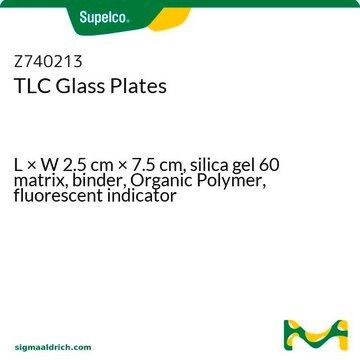1.15326
TLC plates, Silica gel 60
pkg of 100 plates, plate L × W 2.5 cm × 7.5 cm, glass support
Synonym(e):
Silica Gel 60 TLC Plates
About This Item
Empfohlene Produkte
Materialien
glass support
silica gel 60 matrix
Qualitätsniveau
Leistungsmerkmale
binder Organic Polymer
fluorescent indicator: no
Verpackung
pkg of 100 plates
Methode(n)
thin layer chromatography (TLC): suitable
Schichtdicke
250 μm
Platte L × B
2.5 cm × 7.5 cm
Partikelgröße
10-12 μm
Porengröße
60 Å medium pore diameter
Lagertemp.
2-30°C
Verwandte Kategorien
Allgemeine Beschreibung
Anwendung
- Protein-Polymer Conjugates Synthesized Using Water-Soluble Azlactone-Functionalized Polymers: Highlighting the versatility of triethylene glycol monomethyl ether in polymer synthesis, this research develops conjugates for receptor-specific cellular uptake, crucial for targeted drug delivery systems (Kim et al., 2019).
- Hydrogen-bonded six-component assembly for capsule formation: Utilizing triethylene glycol monomethyl ether, this study creates complex capsule structures with applications in material science, particularly for photoresponsive systems (Togari et al., 2018).
- An ultra-small thermosensitive nanocomposite with a Mo(154)-core: This research incorporates triethylene glycol monomethyl ether in the development of a comprehensive platform for NIR-triggered photothermal-chemotherapy, marking a significant advancement in cancer treatment technologies (Zhang et al., 2018).
- Synthesis of Polyester Dendritic Scaffolds for Biomedical Applications: Featuring triethylene glycol monomethyl ether, this article explores its use in the synthesis of polyester dendritic scaffolds, enhancing biomedical applications such as tissue engineering and regenerative medicine (Sadowski et al., 2016).
Verlinkung
Hinweis zur Analyse
Porenvolumen (N₂-Isotherme): 0.74 - 0.84 ml/g
d 50 (Laserbeugung, Kornanalyse): 9.5 - 11.5 µm
Schichtdicke: 210 - 270 µm
Dickenschwankung: ≤ 35 µm
Anwendungstechnische Prüfung:br Farbstofftest
hRf-Werte
- Bleu VIF Organol, Farbstofftest, lipophil:
11 - 25
- Ceresschwarz G, Farbstofftest, lipophil: 34 - 48
- Ceresviolett BRN, Farbstofftest, lipophil: 52 - 67
Trennzahl (Farbstofftest, lipophil): ≥ 9.0
Typischer Wert, gemessen an einer konditionierten Platte
Eluent: Toluol (45% rel. Feuchte)
Analysenzertifikate (COA)
Suchen Sie nach Analysenzertifikate (COA), indem Sie die Lot-/Chargennummer des Produkts eingeben. Lot- und Chargennummern sind auf dem Produktetikett hinter den Wörtern ‘Lot’ oder ‘Batch’ (Lot oder Charge) zu finden.
Besitzen Sie dieses Produkt bereits?
In der Dokumentenbibliothek finden Sie die Dokumentation zu den Produkten, die Sie kürzlich erworben haben.
Kunden haben sich ebenfalls angesehen
Unser Team von Wissenschaftlern verfügt über Erfahrung in allen Forschungsbereichen einschließlich Life Science, Materialwissenschaften, chemischer Synthese, Chromatographie, Analytik und vielen mehr..
Setzen Sie sich mit dem technischen Dienst in Verbindung.






